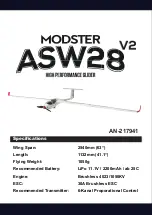
F
Manual
MODSTER ASW 28 V2
29 www.modster.at
The aircraft has to be flown outdoors!
As a precaution, a ground test should always be carried out before the first flight. Performing
a range check is a good way to detect problems that may result in loss of control, e.g. empty
batteries, defective or damaged radio components, or radio interference. This usually requires
an assistant and should be performed on the actual airfield that you are going to be using.
Turn on the transmitter first. Then insert the fully charged battery into the fuselage and secure
with the Velcro. Connect the battery and install the canopyhutl.
Be careful not to strike the throttle stick accidentally. Otherwise, the propeller rotates,
which can cause damage or injury.
Move away from the model while operating the controls in a pattern (eg elevator up, then
down, aileron to the right, then left, rudder to the right, then to the left). When controlling, you
should also vary the engine speed. Contact your assistent if the model does not respond to
the control, or if it is suddenly or irregularly moving. You should be able to keep the control up
to a distance of approx. 100m. If the controls are irregular or otherwise incorrect, make sure
that all the servo cables are properly connected to the receiver and that the control and recei-
ver batteries are fully charged. If you can not find a mechanical problem on the model, it may
be that there is radio interference in this place. One option would be to try a new range check
at an alternative airfield.
Monitor and limit your flight time with a timer or a stopwatch. If the voltage of the batteries be-
comes low, you will normally notice a power drop before the ESC turns off the engine power.
Therefore, you should land the aircraft when it starts to fly slower. Often (but not always!) the
power can be restored shortly after the engine has stopped by holding the throttle for a few
seconds.
To avoid an unexpected dead-stick landing on your first flight, set your timer to 4 minutes.
When the alarm rings, you should land your model. If you know how much flight time you have
in total, you can set your timer accordingly. Always be conservative in your judgment to avoid
the engine turning off unexpectedly and ensuring that you have enough battery to land.
Until you are familiar with your aircraft, you should not fly if the wind speed is more
than 16 km/h.
One final check before take-off:
always double - check the flight control response to your
inputs from the transmitter before every flight.
Make sure that the ailerons, the elevator,
and the control handle react correctly, and that none of the controls have been inadvertently
reversed.
Know Your Frequency
Perfom a Range Check
Before Take Off






































